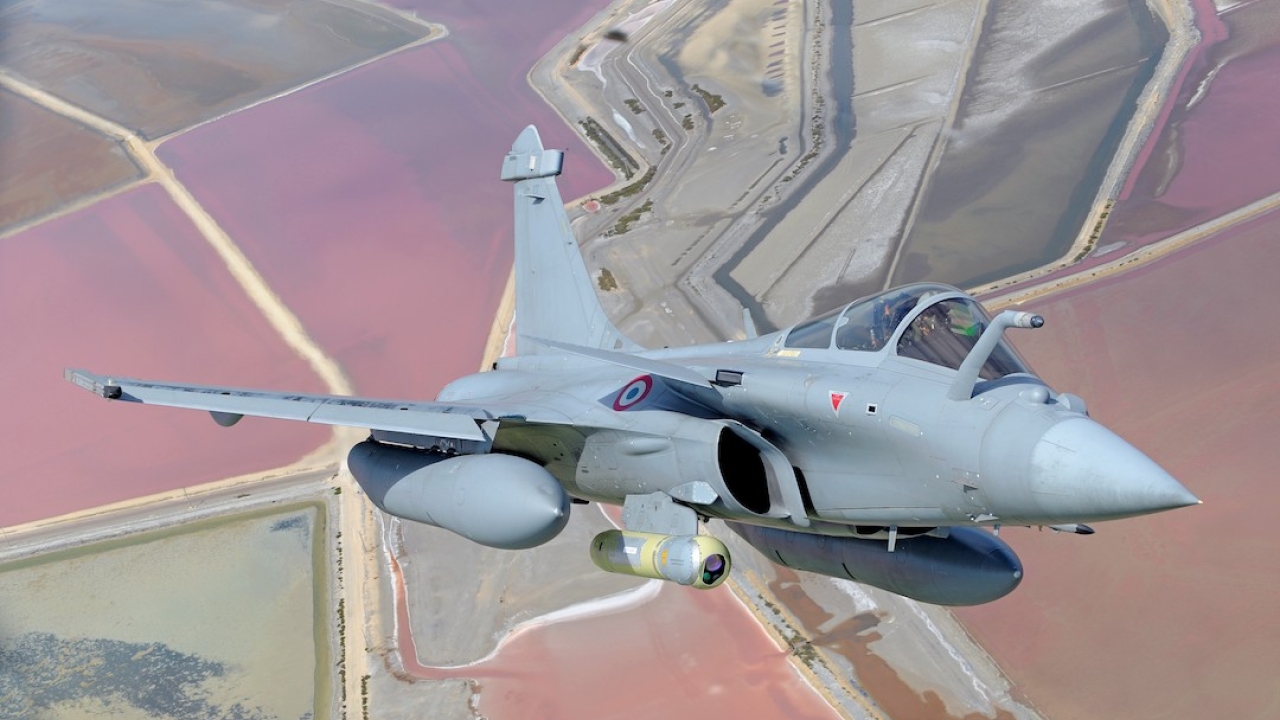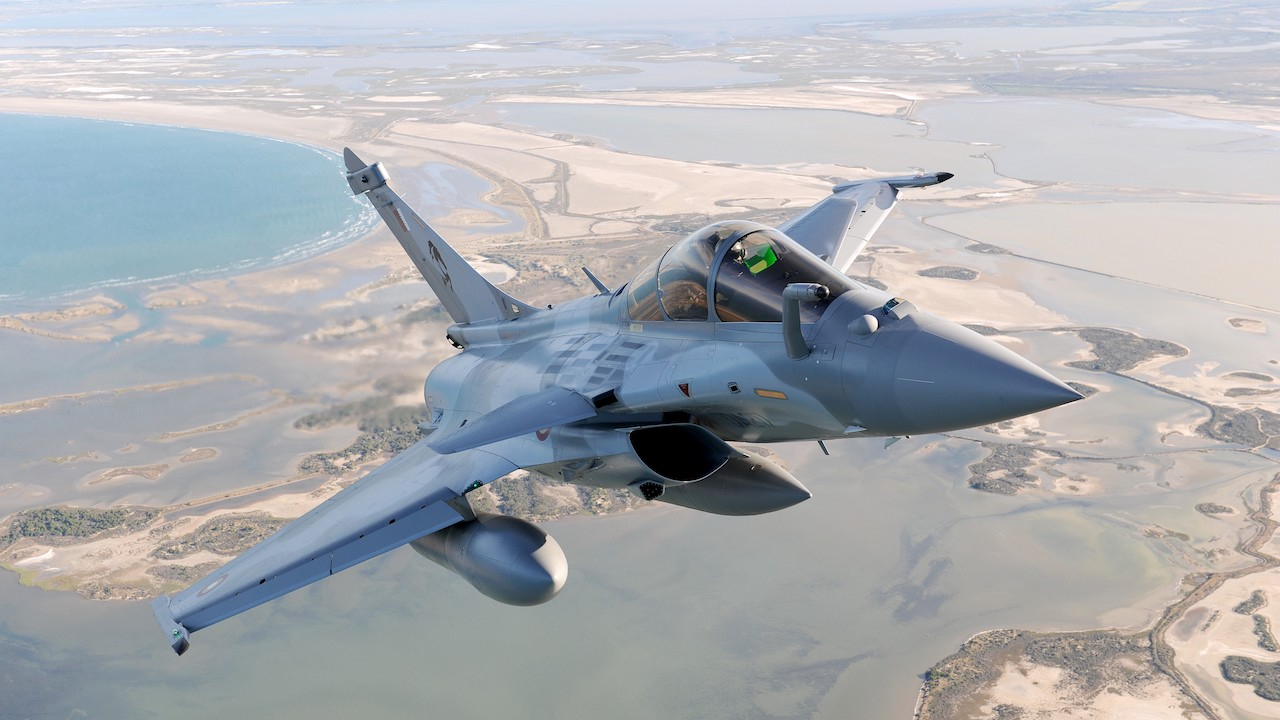Pod cast
Thales claims to be the 'European leader in airborne optronics'. Jon Lake travelled to France to check out some of the company's products.

On target: Talios combines targeting and tactical recce capabilities in a single pod. Picture: Dassault.
Thales is energetically promoting its latest Talios targeting pod, taking aim at a number of MENA air forces, though the company is coy about identifying its customers and sales prospects.
Thales and its predecessor companies (the most recent of which was Thomson-CSF, established in 1968) have produced a succession of targeting pods, including the automatic tracking and laser integration system (ATLIS) used on the Jaguar, Mirage F1 and Mirage 2000, and on some Pakistani F-16 aircraft.
ATLIS was a daylight/clear-weather system, and was replaced by the pod de désignation laser caméra thermique (PDLCT) or thermal camera laser designation pod used on the Mirage 2000D, and eventually by the Damocles pod, which introduced a forward-looking infrared (FLIR) sensor.
Thales co-developed the Damocles pod for the UAE Air Force’s Mirage 2000-9, under the name Shehab. The UAE had been asking France to fund the co-development of an upgraded targeting pod and used the threat of buying the Lockheed Martin Sniper as an incentive!
Damocles featured a long-range laser designator, an integrated navigation FLIR and had a high-resolution reconnaissance capability, transmitting imagery to ground stations in real time. It compared relatively poorly with the contemporary Rafael/Northrop Grumman Litening 3, but scored some export successes with air forces who felt unable to procure the Israeli-designed Litening.
The pod was supplied to the UAE, for carriage by the Mirage 2000-9; Malaysia, for use on the Sukhoi Su-30MKM; Morocco for the Mirage F1CM/EM-VI; and Saudi Arabia, for the Tornado and Typhoon.
After comparative trials between Damocles and the Ural Optical and Mechanical Plant (UOMZ)-produced Sapsan and Solux targeting pods, Russia decided that it would license-produce the Thales Damocles reconnaissance and target designation pod for the Sukhoi Su-24M2, Su-34, Su-27SM and Su-27SM2 attack aircraft.
Thales announced the development of a new Damocles XF variant in 2009, with a refined infrared sensor and a new daylight charge-coupled device (CCD) camera. But development of the XF was subsequently dropped in 2013, in favour of a new pod de désignation laser nouvelle génération (PDL NG) or new generation laser designation pod.
This had a much larger infrared sensor, a TV channel for daylight operation and small target identification, and improved geolocalization using GPS and the aircraft’s internal navigation system.
The PDL NG subsequently became the targeting long-range identification optronic system (Talios).
The pod was flight-tested for the first time on April 28 2016, and Talios was qualified by the French DGA defence procurement agency in 2018 for use on the Dassault Rafale and Mirage 2000D.
The pod entered service on the Aeronavale Rafale M at the beginning of 2020.
The new pod was declared operational on the Rafale F3-Rs of the Armée de l’Air on October 29 2020, and was combat-proven in the Middle East in November 2020.
Thales said that two pods at a ‘forward operating location’ have each amassed 1,000 flying hours, without requiring any maintenance.
Some 20 pods were ordered initially, of a requirement for 45, but these numbers have increased, and 60 pods are now on order, with 30 having been delivered.
Thales said that it has four customers for Talios, though not all of these have taken delivery yet. Apart from the French forces, the pod is known to be in service with Egypt, but other potential operators have selected the Lockheed Sniper, including Qatar and the UAE.
Talios combines targeting and tactical recce capabilities in a single pod. It delivers unmatched image quality, including colour imagery, and uses disruptive capabilities to provide reliable situational awareness in real time.
The pod incorporates a new multi-criteria tracker and has powerful non-traditional information, surveillance and reconnaissance (NTISR) capabilities.
The embedded TrUE AI artificial intelligence system uses a database of some two million reference images to ensure rapid target identification, and is claimed to be 300 times faster at target detection and recognition than a human operator.
A roadmap is already in place for development of Talios, with expanded reconnaissance capabilities, Permanent Vision™ and improved colour pending.
Talios promises to provide greater situational awareness on the connected battlefield, just as operating terrain gets more complex, missions become more diverse, and the quantity of information gathered increases.
Stay up to date
Subscribe to the free Times Aerospace newsletter and receive the latest content every week. We'll never share your email address.


